Most tabletop RPGs function along one underlying fact. You roll dice to determine the success or failure of actions. That means there must be something to gauge those dice against. Most often it’s a static number. Referred to by most in the hobby by the acronym DC or TN, depending on the rules system. And that gets to the point of what we’ll be looking at today: Improving DC/TN in D&D 5e. By creating a system that hinges on one number it is implicitly a simple system and often a binary one.
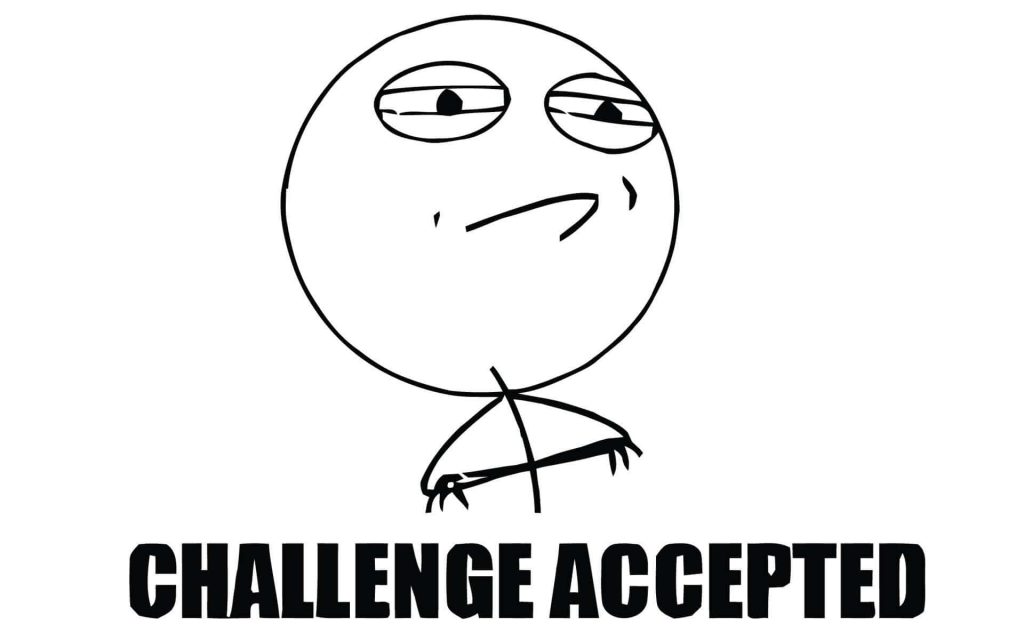
We can do better. There are some games out there that address this, but they’re not d20 style games. So what can we do as DMs to take the best of the rest and change our game mechanics to inject that variety that’s missing? Let’s get started.
How DC & TN Work as Written
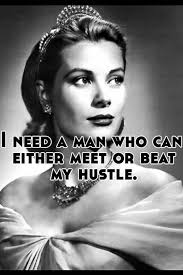
Before we dive into improving DC/TN, let’s look at how the system works now. Contemporary D&D and its derivatives use the unified, d20 roll core mechanic. Anything you want to do you in the game you roll a twenty-sided die and add any numeric modifiers. You check that roll’s totaled sum against a static number that represents the Difficulty Class (DC). Some games refer to this same static number as the Target Number (TN). If your roll’s sum is greater than or equal to the DC, “Meets or Beats”, it is a successful attempt.
That simple, unified core mechanic is one of the reasons D&D is so popular. Always roll the same die, add some numbers, and check it against the DC with the DM. The DM then helps narrate your attempt’s success or failure, explains the updated situation, and then asks some variation of “what do you do?” That’s the core game play loop of D&D.
Critical Success & Failure
There’s one extra bit of mechanics for combat attacks. In addition, to the core DC Meet/Beat mechanic is the “Critical.” These happen when the unaltered die result of an attack roll is a one or a 20.
Natural 1s
Rolling a one on an attack is always a miss, no matter the roll modifiers. That’s a “Critical Failure” or “Critical Miss”.

Natural 20s
Rolling a 20 on an attack is also, always a hit even if the modified result is below the target’s AC. But, if the modified result WOULD hit, the attack becomes a “Critical Hit” or “Critical Success.” These attacks do extra damage and sometimes have added effects.
The simplicity of the system is d20s great strength, but it also offers little variation. At its core, it’s a binary system. Your roll + modifier is either a success or a failure. It’s why people say that playing martial characters (especially fighters) is boring. Roll attack, add total, confirm hit, roll damage. Next!
Pathfinder 2 Degrees of Success
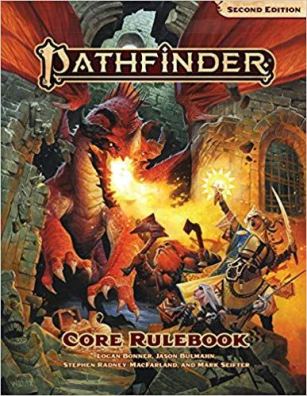
Twenty Nineteen’s Pathfinder 2 attempted to zhuzh up the formula by adding “DC +/-10” as new criteria for criticals. That framework also transferred to non-combat actions. Degrees of success: critical success, success, failure, and critical failure for skill checks.
Sounds great, what’s the problem? If you want that in your game, play PF2 or inject the system into 5e by altering it to +/-5.
Problems in Small Math Frequency
For me, the problem is the increased complexity. It adds another mental math step for the GM. Sure, it’s +/-10, I understand that is as simple a calculation as you could do for the system. But, as a GM I have to do that mental math step for EVERY DIE ROLL minus initiative. That’s a massive mental resource leech for a background task. As a DM/GM I already have a hefty mental load without siphoning energy for the 100+ individual rolls that make up a gaming session.
Problems in Small Math Quantity
This is doubly damning from my perspective. The Pathfinder fork of d20 D&D is already lousy with minuscule, situational modifiers that stack. Meaning many checks devolve into a roll and then up to 60 seconds of someone adding all the +1/2/3 and -1/2/3 situational modifiers. Adding more mental math load to the system makes me want to play it less, not more.
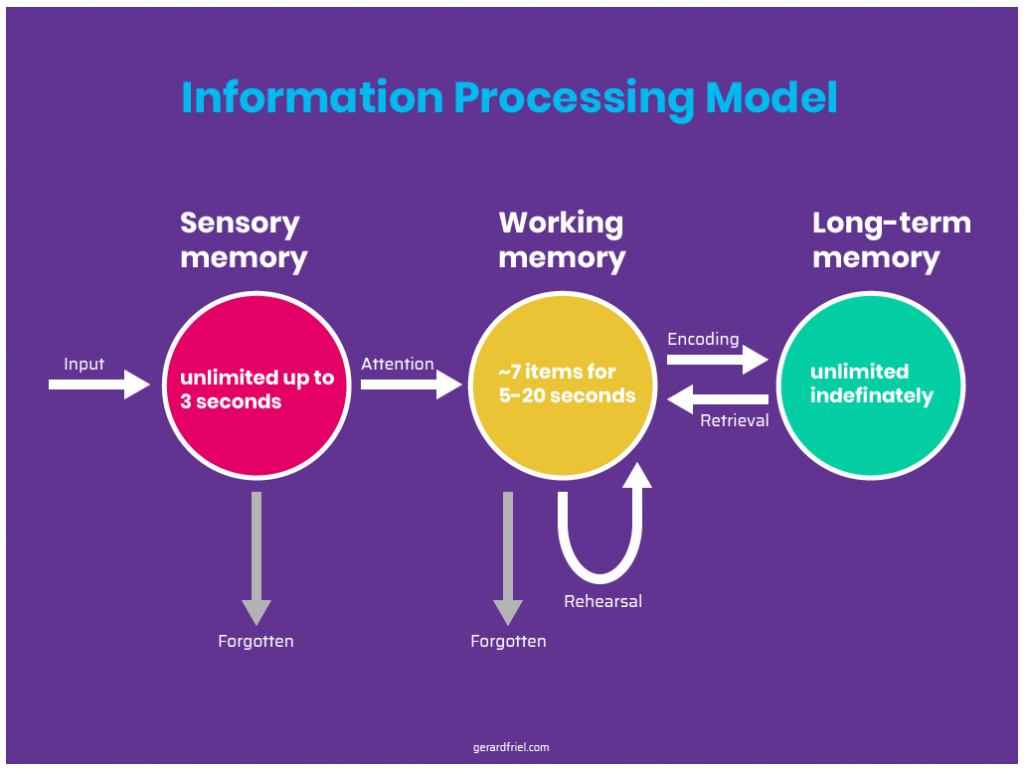
The underlying problem for the d20 core mechanic is it’s simple, but not varied in its results. And that attempts to vary the results add more cognitive load to the DM. But, there is an existing rules system that is closer to that ideal scenario.
Fantasy Flight’s Star Wars
My first exposure to Fantasy Flight’s Star Wars tabletop RPG was, I think like many, the dice. I saw the dice and wondered what they were. Most RPGs fall into one of two camps on dice. Roll one die and add modifiers OR roll a pool of one die type totaling successes.
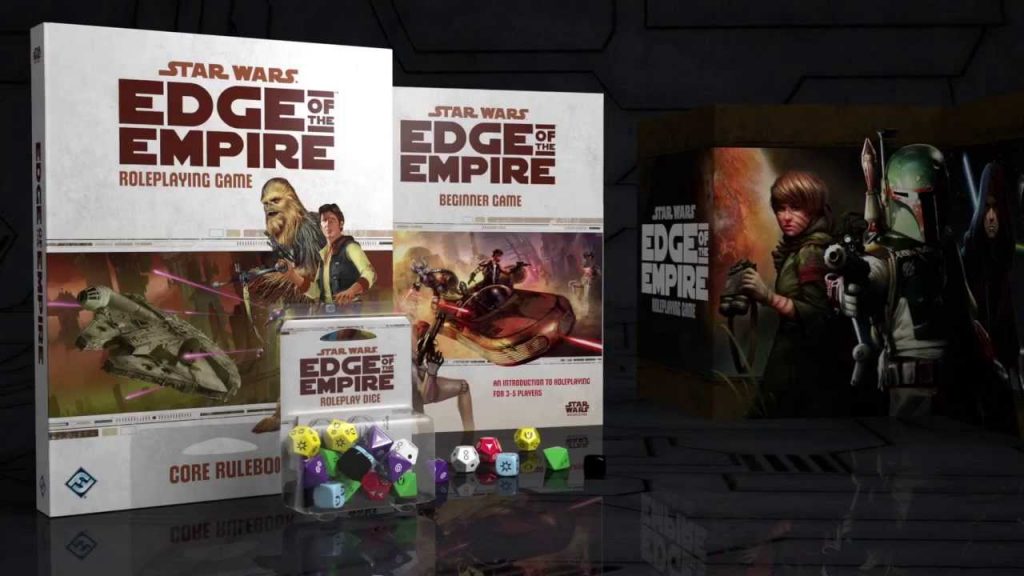
Fantasy Flight’s Star Wars games (Edge of the Empire, Age of Rebellion, Force of Destiny) use the dice pool system with a variant. The pool is built from different types of dice depending on the situation. The dice come in different sizes and layout depending on what they represent. And the dice don’t have numbers.
Fast & Dirty Dice Explanation
Each creature has a Characteristics (Ability Score) Rating and a Skills Rating to determine the basic dice pool for a check. The larger number tells you how many dice to roll and the smaller number tells you which kind of dice.
The dice pool is also increased by modifiers from gear, circumstance, and aid. The GM adds challenge by injecting bad dice to the pool determined by the difficulty, danger, and situation.
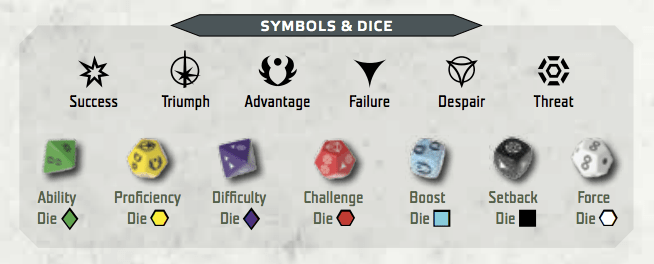
Star Wars Dice Faces
Each die has a different combination of possible results on its faces. For each test roll you cancel out any opposing symbols and tally the final result of the test. Then the player and GM interpret the dice result.
Success & Failure
Cancel each other out. You only need one positive success to accomplish a task or hit an enemy.
Advantage & Threat
Cancel each other out. Tells you if there are any side effects or consequences that happen due to the attempt.
Triumph & Despair
Counts as a success/failure and cannot be cancelled out. Used to invoke a powerful positive/negative consequence due to the attempt. Can rarely create a situation that is both a success and a failure.
More than Success & Failure Binary
Each roll can include a wide range of results comprised of powerful consequences, side effects, and success/failure. And, while Star Wars provides examples of symbol interpretation, it empowers the GM to translate the results into something appropriate for the situation.
It’s the consequences and side effects I find that’s missing from d20 systems. As a GM of any tenure you’re familiar to the improv mantra of “Yes, and” and how GMs can use that mindset to improve their game. I want a system that helps make that happen mechanically. That’s the power of Fantasy Flight’s Star Wars.
Improving DC/TN Adjudication Building Blocks
Our first criteria is using the improv mantra and its forgotten shadow twin “No, but.” The second criteria to keep in mind is Fantasy Flight’s dice symbols. With that we can create six possible outcomes for our rolls.
The Six Possible Outcomes for Improving DC/TN
- Success, and a Positive Side Effect
- Success
- Success, but a Negative Consequence
- Failure, but a Positive Side Effect
- Failure
- Failure, and a Negative Side Effect
First Attempt Thoughts
The original thought was to add a+/-5 modifier for each degree of success. But, that puts us right back in the same situations as Pathfinder 2.
It’s very easy to fall into that trap, because most TTRPG design works like that. “Need an adjustment? It’s +/- a few numbers.”
We want to reduce the cognitive load, that’s why Natural 20/1s and mechanics like Advantage/Disadvantage work so well. You don’t have to think, you see and react. You don’t have to think about rolling 2d20s and taking the higher/lower. You don’t have to think when you see that Natural 20 or Natural 1 staring back at you. It’s simple recognition and reaction, no mental math.
With those additional thoughts I came back with this outcome layout.
The Five Outcomes for Improving DC/TN
- Success, And
- Success
- Success/Failure, But
- Failure
- Failure, And
Harder, Better, Faster, Stronger Adjudication
Off the bat, the new arrangement has five levels. Like three, five is a design number that pleases the human brain. Also, none of the degrees of success need cognitive thought; simple recognition and reaction. That makes the system easier to use, but for the median level. The median result is a very special level and provides the heavy lifting of improving DC/TN. We’ll get to that, but first let’s run through the other levels.
Success, And
This is your critical success. You make a check, you roll a Natural 20. Doesn’t matter if it’s an attack, a skill, or a saving throw. You crit, when you crit. Now, standard DM advice applies. It has to be a plausible situation where you COULD succeed. You swan dive off a 50-story building? No Dexterity save or Acrobatics check is going to save you from sidewalk pancake insta-death. DMing 101 still applies.
DM 101: Calling for Checks/Rolls
When determining to call for a check/roll consider…
1) Can this creature plausibly succeed at the attempt?
2) Is there any consequence for failing the attempt?
If either of those questions is no, there’s no reason to roll.
Dynamic “Yes, And” Success
Focus less on the success part, we know what that means. Focus on the “And”. Think of it as momentum for the creature. You can make situations dynamic by using Fantasy Flight’s idea of adding positive side effects/consequences while improving your DC/TN. Most d20 scenes happen in a room and the scenery doesn’t change or impact the scene. It’s colorful paint on a backdrop. You can use the scenery and make it a vibrant, even mechanically important, part of your game.
For inspiration, investigate the Star Wars’ side effect tables and Fantasy AGE’s stunt tables. These are great places to start thinking of appropriate “AND” boosts. And both provide examples of social and exploration scene boosts.
Success & Failure, Not-So-Improved DC/TN
Does what it says on the tin. Variety is the spice of life and spices should be used sparingly for greatest impact. If every turn of combat needs a three sentence description, combat will take forever. Well… foreverER. Modern d20 combat already takes a significant sink of table time. Our issue is to make the game less bland, not to stretch out each scene.
Improved “Failure, And”
This is your critical failure. You make a check, you roll a Natural 1. Doesn’t matter if it’s an attack, skill, or a saving throw. You roll a one, you fail. Like with “Success, And”, it’s important to know when to roll and when to narrate. No need to make a character check to unlock a car door with a key unless they’re chased by an 80’s slasher horror villain.
Edge creatures into a disadvantageous situation with a critical fail for greatest impact.
NOTE: This Success/Failure adjustment will not address the multi-attack problem. The more skilled a martial combatant the more attacks they get and consequently the more Natural 1s they roll.
Success/Failure, But and Player Choice
This is the game changer degree of success for improving DC/TN. It happens when a check exactly meets the DC/TN. And this is where we inject player choice into the situation. A player can decide to have a success by suffering a consequence or sacrificing something. Or they can opt for the miss and instead create a personal advantage or consequence on the target.
Now players will need to weigh the importance of success now with a drawback versus creating an opportunity for later success.
Simplicity & Power
The only number you need to remember to run the 5 outcome system is the DC and it requires zero cognitive load to run the numbers.
The degrees of success recreate fluid and dramatic action reminiscent of a cinematic fight scene. You can easily create a scene where an attacker hits, but gets disarmed in the process and the defender kicks the weapon across the room.
Collaborative Design
The system design for improving DC/TN is free form and collaborative. It encourages the players to bring their own advantages, disadvantages, and sacrifices to the table. Of course, you don’t have to do that if you want more situation control or you have neophyte players. But, work to get your players engaged and give them agency. Many will enjoy getting a little extra decision making and RP opportunity in combat.
Try to involve other characters. Don’t just give the roller advantage/disadvantage. Use the system to encourage players to use the environment and practice teamwork. In the example below you’ll see I hand out advantage on attacks to players who aren’t the active player. I also gave one of the bad guys a free attack because it felt applicable for the situation. Players are looking for more than just another way to get advantage in combat. It’s about creating scenes with action that flow.
Improving DC/TN Combat Example
In a standard combat encounter example, Mad Maggie makes a great axe attack against the cultist (AC 13).
Success, And
“Natural 20, nice! It’s a success, do your crit damage AND tell me how Maggie puts the cultist at a disadvantage!”
Success
“Maggie sinks her axe into the cultist who lets out scream of pain. Roll damage.”
Success, But
“Right on the nose. Do you want to hit and take a drawback or miss and create an advantage? …Awesome, roll damage. You sink the axe into the cultist BUT he grabs onto the haft and keeps you from pulling it free.”
Failure, But
“Right on the nose. Do you want to hit and take a drawback or miss and create an advantage? …Excellent. The cultist twists away from your axe and you catch just his robes. He spins around off balance granting advantage to the next attack targeting him before your next turn.”
Failure
“Oof, just missed. The cultist backpedals from your swing and hisses.”
Failure, And
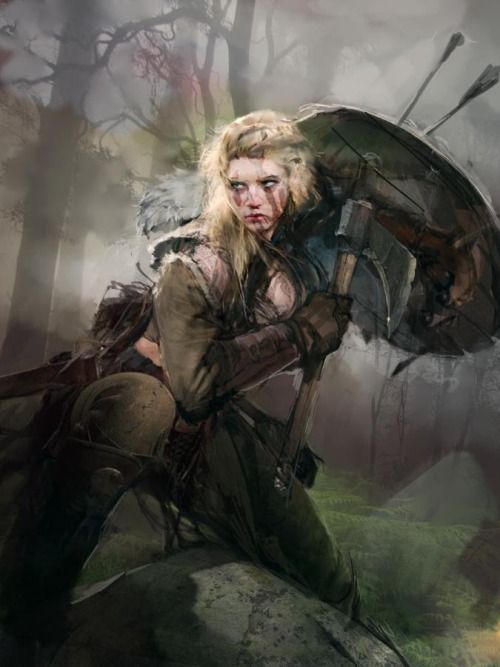
“Natural 1? That’s great news for the cultist. As you pull the axe back to strike it catches on a pillar, leaving you open. The cultist is going to spend his reaction to try and stab you.”
You can see the five different outcomes of the same attack action. Some great, some familiar, some bad. The important thing is creating dynamic scene variety. Make combat more than players rolling dice and saying numbers back and forth.
But not all scenes are combat scenes. The odd player will interact with the environment or even try to talk to NPCs. [That’s not normal gif] Not the average murderhobo player for sure, but we want those weirdos to have fun too. Here’s an example of the same system used to adjudicate a skill roll.
Improving DC/TN Ability (Skill) Check Example
Dustin the Dexterous attempts to pick a locked door (DC 13) before the goblins find the party. NOTICE THE FAILURE CONSEQUENCE
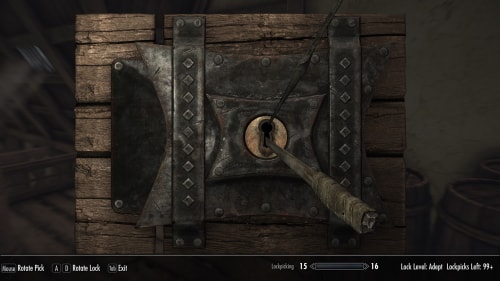
Success, And
“Natural 20, perfect. Dustin’s fingers are a flurry of motion. You unlock and open the door in dead silence. You see a goblin on the other side of the room, back to you, engrossed in searching a crate.”
Success
“Your picks move along the lock like second nature until you feel a soft release of pressure; child’s play. What do you do?”
Success, But
“That’s the DC. You want the success and consequence or the failure with boon? …You open the lock, but doing so causes the metal to squeal. Drawing the attention of whatever is on the other side of the door.”
Failure, But
“That’s the DC. You want the success and consequence or the failure with boon? …You’re so close, but the cylinder won’t completely turn. If you hold it someone can force the door open without breaking it and you can lock it behind you as the goblins arrive.”
Failure
“The nerves get to you and you can’t seem to get the tumblers aligned. A bead of sweat drips from your brow as the pursuing goblins turn the corner and close the distance. Roll for initiative!”
Failure, And
“It’s no use, the door is locked fast and the pursuing goblins catch up to you. Dustin, behind the door you can hear a goblin voice raising the alarm.”
If you follow your DM 101 advice on when to call for checks the system works great for non-combat situations. So take this system and try it out in your next game session. Put it to task and see how it improves your game. And make sure to share your results with me on Twitter @RedRaggedFiend. And follow me if you’re not already.
Improving DC/TN Part 2
Next time, we’ll continue the conversation on improving DC/TNs in Part II. We’ve upped how to adjudicate checks, but we haven’t addressed the number side. We’ll talk about how to set difficulty and how to set up a system for complex task resolution.
Hungry for more? Check out this post about knowing when to call for rolls as a DM and avoiding dead end failures. I also provide downloadable content on DriveThruRPG. All items are Pay-What-You-Want and profits support the website. Check out Random Treasure Tables, five pages of treasure better than a pile of coins for stocking your adventures and dungeons.

Pingback: Upgrading D&D DC/TN Part II | Red Ragged Fiend